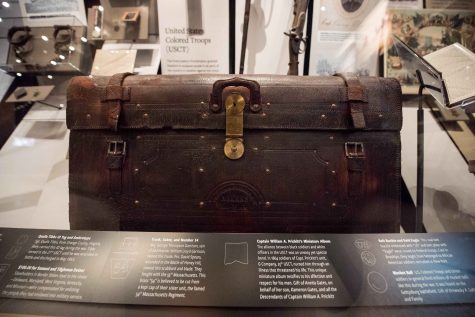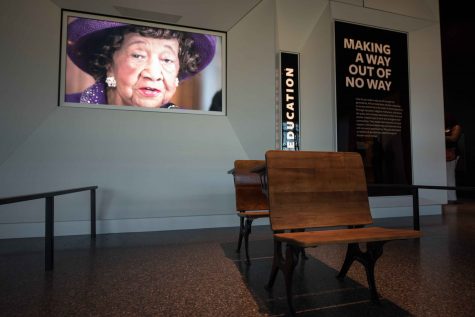New African-American museum in DC was 100 years in the making
Desks and a wood burning stove from the Hope School are on display at the Smithsonian National Museum of African American History and Culture on Sept. 14, 2016 in Washington, D.C. (Ken Cedeno/McClatchy/TNS)
September 21, 2016
WASHINGTON — The National Museum of African American History and Culture may have started out at a distinct disadvantage. But it has already begun to overcome its humble roots.
The first of the Smithsonian Institution’s 19 museums to begin without a dedicated collection, its 3,000-plus artifacts were mostly donated from private individuals and organizations.
Yet already, more than 100,000 people have registered as museum members, a Smithsonian record.
Advertisement
Designed to resemble an African wooden column, the museum’s exterior is covered with 3,600 bronze-colored aluminum panels that resemble 19th-century ironwork created by New Orleans slaves.
The $540 million, 400,000-square-foot facility comes more than 100 years after black Civil War Union Army veterans first called for a memorial to honor the contributions of black soldiers and other African-Americans in 1915.

Traveling trunks used by George Thompson Garrison in the Civil War are on display at the Smithsonian National Museum of African American History and Culture on Sept. 14, 2016 in Washington, D.C. (Ken Cedeno/McClatchy/TNS)
President Calvin Coolidge signed legislation in 1929 authorizing a “National Memorial Commission” to construct a building to serve as a tribute to African-American contributions. But racial opposition in Congress blocked the appropriation of seed money. The stock market crash of 1929, the Great Depression and World War II also kept the project from moving forward.
It wasn’t until December 16, 2003, when President George W. Bush signed legislation creating the National Museum of African American History and Culture, that the effort finally began to take shape.
Some view the museum as a small down payment on reparations and recognition owed to African-Americans after centuries of state-sanctioned bondage, inhumanity, violence and disenfranchisement in the United States.
The attitude is understandable, considering the horror of the Middle Passage, the false promise of Reconstruction, the shame of Jim Crow and the nation’s violent resistance to the civil rights movement.
But others see the museum as a long-overdue acknowledgment of America’s great failings on race and a salute to the resilience, faith and pride that helped African-Americans overcome it and thrive.
Advertisement*
Just as pressure that bursts pipes can also produce diamonds, the museum, which will be dedicated Saturday by President Barack Obama, explores the nation’s faulty racial plumbing and the priceless cultural gems that somehow came spewing out.
They include people like Muhammad Ali, Harriet Tubman, Frederick Douglass, Dr. Daniel Hale Williams and Ida B. Wells.
They also include jazz, blues and hip-hop — creative self-expressions of pain and pride that drew from African oral and rhythmic traditions. Yet they are all uniquely American art forms.

Desks from the Hope School in Pomaria, S.C. are on display at the Smithsonian National Museum of African American History and Culture on Sept. 14, 2016 in Washington, D.C. (Ken Cedeno/McClatchy/TNS)
“The music, dance, distinctive foods, art and artists that people outside the United States associate with ‘American culture’ were and are originally African-American,” said an email from V.P. Franklin, professor emeritus of history at the University of California, Riverside and editor of The Journal of African American History. “White Americans are much more African-American than most will admit.”
Serving as a portal to the past and window to the future, the museum has the capacity to “touch lives and transform the way people see the world and interact with each other,” Smithsonian Secretary David Skorton said.
That theory will be put to the test almost immediately.
“Opening now at a time when social and political discourse remind us that racism is not, unfortunately, a thing of the past, this museum can, and I believe will, help advance the public conversation,” Skorton said.
___
(c)2016 McClatchy Washington Bureau
Visit the McClatchy Washington Bureau at www.mcclatchydc.com
Distributed by Tribune Content Agency, LLC.
Advertisement








